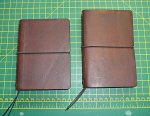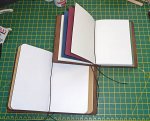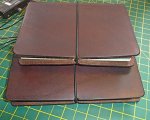N
Nomad
Guest
(Full disclosure: I'm considering upgrading to a maker account and making some of these to sell.)
I like to have some sort of small notebook that I can carry in a pocket. They get used for jotting down short term things that I might otherwise forget, like shopping and to-do lists, as well as notes related to film photography, and sketches when I have an idea in my head for something to make, or just need to visualise something quickly. Nothing permanent - anything I want to keep or develop further gets reworked in a more suitable form later.
In the past, I've used the casebound hardback Moleskine and Leuchtturm notebooks, as well as a small Filofax style loose leaf jobbie. While they do the job, the casebound ones get grubby, the bookmark ribbons fall out, etc; and I find the loose leaf thing too loose when handling the pages, and has very limited capacity (it's a nice size, but has tiny rings, and the pocket ones with bigger rings are too bulky).
More recently, I've become aware of what is generally known as a traveller's notebook. These are basically a leather cover with an elastic loop in the spine to hold a single stapled notebook (the elastic going down the middle of the insert), and another loop on the outside to act as a closure. There is a trick that can be done with a second elastic loop in the spine to expand the capacity up to three notebooks, but it's not especially good - the stretchy elastic means the spines of the notebooks compete for space within the cover, such that the binding is floppy and uneven, and the whole binding part is quite bulky due to the thickness of the elastic. Another issue is with the closure - for some odd reason, the outer elastic loop is fitted through a hole in the middle of the back of the cover and retained by tying a knot in the elastic that's big enough to not go through the hole. Obviously, this bizarre lump gets in the way when you're writing. There's also another lump on the outside of the spine at the top, where there is some sort of retainer thing for the primary elastic loop that holds the notebook(s) in place.
I reckoned I could do better, and decided to make two, using notebook inserts of different sizes, to see which I preferred...

They're both made from 2mm veg tan leather, and are both 100mm wide. The one on the left is 134mm tall, and the one on the right 150mm tall.
The smaller one has three Midori Passport size inserts which each have 64 pages, and the other has three Field Notes inserts, each with 48 pages. The inserts are mixed - lined, plain, and squared. I quite like the squat form factor of the smaller one, but the Midori inserts seem to be an uncommon size at 9x12.5cm (3.5 x 5"). The Field Notes ones are 9x14cm (3.5 x 5.5"), and I've noticed that other brands make stapled or sewn simple notebooks in this size as well.
Anyway, I elected to use thin, strong cord for the binding rather than thickish round elastic, and to use one binding for each insert. That way, the three inserts are all held nicely at the spine of the cover and don't get in each others way. With the elastic binding method, what happens is the middle insert stays close to the spine, but the two outer ones get pushed away due to a combination of the curve of the leather forcing them out and the stretchy elastic doing nothing to prevent this. With a bit of wet forming of the leather and carefully positioned non-stretchy binding, everything is that bit more tidy...

When opened, they both lie flat enough to be easy to write in...

Not quite as coherent in handling as a good casebound notebook, but everything stays in place well enough. Note that the binding cord is kept long at the top, meaning each insert also has its own place marker. So far, I've found them absolutely fine for flipping through pages, opening a given insert, etc.
Here's a view of the spines of the covers...

No lump sticking out at one end that's used to keep the main elastic binding in place, which would be another thing to get in the way of writing - I wanted to ensure that the whole thing would lie flat and be easy to use. The routing of the elastic closure can be seen here as well - it goes into the spine rather than into the middle of the back cover. It also passes through two small holes and has two small knots to keep it in place, rather than putting both lengths through one bigger hole and having a big knot in the middle of the book's spine. The holes/knots also lie between the spines of the inserts. This is much more low profile.
Finally, I put a couple of notches in the edges of the covers to locate the elastic...

These keep it in place when the book is going in and out of a pocket or bag, and also provides a nice tactile indication that the elastic is located correctly when closing the book.
I've played around with fountain pens to see what the paper is like, and I would say that the Midori paper is marginally better than the Field Notes. It's maybe a tiny bit smoother, and is a bit more resilient to show-though on the other side of the paper. There was no actual bleed-through on either. Oddly, a pen with a fine nib (deposits less ink) shows through a bit more than one with a medium nib (same brand of ink in both, both dark colours). For a notebook that isn't intended to contain works of art, neither brand of paper is remotely problematic in this regard.
I found that fitting the Midori inserts was a bit tricky compared to the Field Notes. The binding loops aren't stretchy, so they need to provide enough room to allow the inserts to be fitted while not letting things get loose and floppy.I did this by tying each loop over the full thickness of an insert, meaning half of the thickness passes through the loop when it's fitted. This seems to give a good balance between room to get the insert in, and keeping things in place without being too tight or too loose. The reason the Field Notes ones were easier is because they have rounded corners - the two ends can be eased in more readily. With the square-cut Midori corners, it seemed that one end would pop out just as the second one went in. They're both doable, but the Midori is just a bit more fiddly.
In terms of size, either one readily fits into a moderate jacket pocket - they're not much bigger than the typical pocket size Moleskine or Leuchtturm, although are a bit thicker. It's still a small notebook that fits easily in a pocket, satchel, handbag, etc. Interestingly, they both weigh about 150-160g, and a pocket size Leuchtturm is 155g.
When I started this, it was to try and make a Midori-sized notebook cover without the design flaws. When I went to order the inserts, I noticed the other brands in the slightly larger size, so ordered the Field Notes ones as well with a view to making two covers to see how they compared. So far, I'm leaning towards the slightly taller version, which also happens to be a bit slimmer.
As a type of notebook, I find them interesting - they're more versatile than a casebound type, which generally only has one type of marking on the paper. Lines are good for lists and notes, but plain is better for sketches. Sqaured can be handy for more considered design sketches and basic scale drawings. Another approach is to use it in a semi-loose leaf fashion, where each insert is allocated to a specific purpose, and is changed out for a new one when it's filled. Unlike the little Filofax loose leaf things, these have a much more compact binding than the rings, meaning there's much more capacity for a given size. So, this approach is kind of in between casebound and loose leaf. The Field Notes one will be living in my vest-of-pockets, and I'll see how it goes.
I like to have some sort of small notebook that I can carry in a pocket. They get used for jotting down short term things that I might otherwise forget, like shopping and to-do lists, as well as notes related to film photography, and sketches when I have an idea in my head for something to make, or just need to visualise something quickly. Nothing permanent - anything I want to keep or develop further gets reworked in a more suitable form later.
In the past, I've used the casebound hardback Moleskine and Leuchtturm notebooks, as well as a small Filofax style loose leaf jobbie. While they do the job, the casebound ones get grubby, the bookmark ribbons fall out, etc; and I find the loose leaf thing too loose when handling the pages, and has very limited capacity (it's a nice size, but has tiny rings, and the pocket ones with bigger rings are too bulky).
More recently, I've become aware of what is generally known as a traveller's notebook. These are basically a leather cover with an elastic loop in the spine to hold a single stapled notebook (the elastic going down the middle of the insert), and another loop on the outside to act as a closure. There is a trick that can be done with a second elastic loop in the spine to expand the capacity up to three notebooks, but it's not especially good - the stretchy elastic means the spines of the notebooks compete for space within the cover, such that the binding is floppy and uneven, and the whole binding part is quite bulky due to the thickness of the elastic. Another issue is with the closure - for some odd reason, the outer elastic loop is fitted through a hole in the middle of the back of the cover and retained by tying a knot in the elastic that's big enough to not go through the hole. Obviously, this bizarre lump gets in the way when you're writing. There's also another lump on the outside of the spine at the top, where there is some sort of retainer thing for the primary elastic loop that holds the notebook(s) in place.
I reckoned I could do better, and decided to make two, using notebook inserts of different sizes, to see which I preferred...

They're both made from 2mm veg tan leather, and are both 100mm wide. The one on the left is 134mm tall, and the one on the right 150mm tall.
The smaller one has three Midori Passport size inserts which each have 64 pages, and the other has three Field Notes inserts, each with 48 pages. The inserts are mixed - lined, plain, and squared. I quite like the squat form factor of the smaller one, but the Midori inserts seem to be an uncommon size at 9x12.5cm (3.5 x 5"). The Field Notes ones are 9x14cm (3.5 x 5.5"), and I've noticed that other brands make stapled or sewn simple notebooks in this size as well.
Anyway, I elected to use thin, strong cord for the binding rather than thickish round elastic, and to use one binding for each insert. That way, the three inserts are all held nicely at the spine of the cover and don't get in each others way. With the elastic binding method, what happens is the middle insert stays close to the spine, but the two outer ones get pushed away due to a combination of the curve of the leather forcing them out and the stretchy elastic doing nothing to prevent this. With a bit of wet forming of the leather and carefully positioned non-stretchy binding, everything is that bit more tidy...

When opened, they both lie flat enough to be easy to write in...

Not quite as coherent in handling as a good casebound notebook, but everything stays in place well enough. Note that the binding cord is kept long at the top, meaning each insert also has its own place marker. So far, I've found them absolutely fine for flipping through pages, opening a given insert, etc.
Here's a view of the spines of the covers...

No lump sticking out at one end that's used to keep the main elastic binding in place, which would be another thing to get in the way of writing - I wanted to ensure that the whole thing would lie flat and be easy to use. The routing of the elastic closure can be seen here as well - it goes into the spine rather than into the middle of the back cover. It also passes through two small holes and has two small knots to keep it in place, rather than putting both lengths through one bigger hole and having a big knot in the middle of the book's spine. The holes/knots also lie between the spines of the inserts. This is much more low profile.
Finally, I put a couple of notches in the edges of the covers to locate the elastic...

These keep it in place when the book is going in and out of a pocket or bag, and also provides a nice tactile indication that the elastic is located correctly when closing the book.
I've played around with fountain pens to see what the paper is like, and I would say that the Midori paper is marginally better than the Field Notes. It's maybe a tiny bit smoother, and is a bit more resilient to show-though on the other side of the paper. There was no actual bleed-through on either. Oddly, a pen with a fine nib (deposits less ink) shows through a bit more than one with a medium nib (same brand of ink in both, both dark colours). For a notebook that isn't intended to contain works of art, neither brand of paper is remotely problematic in this regard.
I found that fitting the Midori inserts was a bit tricky compared to the Field Notes. The binding loops aren't stretchy, so they need to provide enough room to allow the inserts to be fitted while not letting things get loose and floppy.I did this by tying each loop over the full thickness of an insert, meaning half of the thickness passes through the loop when it's fitted. This seems to give a good balance between room to get the insert in, and keeping things in place without being too tight or too loose. The reason the Field Notes ones were easier is because they have rounded corners - the two ends can be eased in more readily. With the square-cut Midori corners, it seemed that one end would pop out just as the second one went in. They're both doable, but the Midori is just a bit more fiddly.
In terms of size, either one readily fits into a moderate jacket pocket - they're not much bigger than the typical pocket size Moleskine or Leuchtturm, although are a bit thicker. It's still a small notebook that fits easily in a pocket, satchel, handbag, etc. Interestingly, they both weigh about 150-160g, and a pocket size Leuchtturm is 155g.
When I started this, it was to try and make a Midori-sized notebook cover without the design flaws. When I went to order the inserts, I noticed the other brands in the slightly larger size, so ordered the Field Notes ones as well with a view to making two covers to see how they compared. So far, I'm leaning towards the slightly taller version, which also happens to be a bit slimmer.
As a type of notebook, I find them interesting - they're more versatile than a casebound type, which generally only has one type of marking on the paper. Lines are good for lists and notes, but plain is better for sketches. Sqaured can be handy for more considered design sketches and basic scale drawings. Another approach is to use it in a semi-loose leaf fashion, where each insert is allocated to a specific purpose, and is changed out for a new one when it's filled. Unlike the little Filofax loose leaf things, these have a much more compact binding than the rings, meaning there's much more capacity for a given size. So, this approach is kind of in between casebound and loose leaf. The Field Notes one will be living in my vest-of-pockets, and I'll see how it goes.

